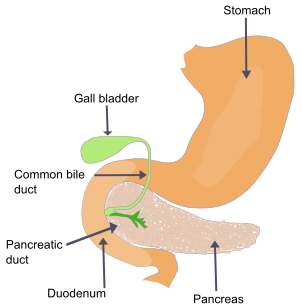Digestive Health
Your Gallbladder
By Tammera J. Karr, PhD., BCHN ©2012
 Did you know you can have gall bladder stones after having your gallbladder removed? It’s true for all those individuals out there who have had their gallbladder removed, you can still develop stones in the ducts that lead to the gall bladder from the liver. Your gallbladder is a small pear-shaped organ in the abdomen and holds the digestive fluid bile. People suffering from gallbladder disease, or who have recently had gallstone surgery, may benefit from following a low-fat and low-cholesterol diet[1],[2], but there is also a familial tendency to consider.
Did you know you can have gall bladder stones after having your gallbladder removed? It’s true for all those individuals out there who have had their gallbladder removed, you can still develop stones in the ducts that lead to the gall bladder from the liver. Your gallbladder is a small pear-shaped organ in the abdomen and holds the digestive fluid bile. People suffering from gallbladder disease, or who have recently had gallstone surgery, may benefit from following a low-fat and low-cholesterol diet[1],[2], but there is also a familial tendency to consider.
While getting gallstones after a cholecystectomy (removal of the gallbladder) is rare, it can occur and will require medical treatment. To understand how gallstones can return after gallbladder surgery, it is essential to understand the function of the gallbladder and how gallstones are formed.
Located just under the liver, the gallbladder is connected by the common bile duct to the liver. The liver produces bile, goes into the gallbladder. When we consume food, the gallbladder contracts and releases the bile through the common bile duct which travels into the small intestine. Bile is a fluid-like substance that helps digest the fats in the foods we consume.
Cholesterol in the bile forms deposits that resemble stones that can range in size from a tiny grain of sand to even golf ball size. These deposits are known as gallstones. While almost everyone has gallstones, only a portion of the population will develop complications from having these deposits. These complications occur when the gallstones block or become lodged in the duct, blocking the flow of bile. Although these stones will not be found in the gallbladder since the gallbladder has been removed, they can form in the bile ducts. This condition known as choledocholithiasis can cause the stones to travel and block the pancreatic duct if left untreated.
Symptoms can range from minor to severe pain in the upper abdomen, upper back pain, nausea, and/or vomiting. Many times individuals may believe they are experiencing major indigestion and do not seek medical attention until the pain becomes unbearable.[3]
Bile aids in the digestion of fats. After the gallbladder has been removed, the body may not produce enough bile to properly digest fats, resulting in upset stomach and diarrhea. To help prevent those symptoms, avoid hydrogenated oils, margarine, saturated fats and fried foods. You should not eliminate all fats from your diet. Healthy fats such as olive oil, and omega-3 fatty acids should be included in small amounts as the body benefits from these healthy fats.
Fiber, with proper fluid intake, moves through the digestive tract with little effort, keeping the tract free of blockages. High fiber choices include whole wheat pasta, oatmeal, split peas, lentils and black beans. According to the Mayo Clinic, you should try to consume 25 to 38 g of fiber per day.
After the gallbladder has been removed, a diet that includes plenty of fresh, organic fruits and vegetables is beneficial to help you heal. In addition to providing fiber, fresh fruits and vegetables are low-fat and contain needed vitamins and minerals. Recommended fruits and vegetables include beets, cucumbers, onions, garlic, grapes, lemons, tomatoes, apples and berries. [4]
The Mayo Clinic recommends taking a vitamin supplement; not getting enough vitamin C, vitamin E or calcium may cause you to experience digestive discomfort. Add turmeric and ginger to meals, both aid in bile production and fat digestion. When dining at restaurants, keep dressing off of salads, select grilled chicken or fish, and order rice or potato without butter or sour cream.
When questioning my client shared that their mother had had stones after her gallbladder was removed and their current symptoms were the same as when they first went in to have their gallbladder removed. When the client was examined by a GI specialist he explained their bile duct may be full of sludge which it turned out to be, the client has since had a procedure to clear this tar from their bile duct. When I asked the specialist what would be the outcome if the client chose to not have sugary done, their response was cirrhosis of the liver would be likely. And if you were wondering, they client has better eating habits with organic foods as the staple, and no fast food or high fat foods as part of their diet for years as a cancer preventative.
Take Back Control of Your Health with Information.
[1] http://www.livestrong.com/article/346199-diet-after-gallstone-surgery/
[2] http://www.helium.com/items/1169768-gallstones-after-having-the-gallbladder-removed
[3] http://voices.yahoo.com/preventing-gallstones-after-gallbladder-removal-2102510.html
[4] http://www.livestrong.com/article/346199-diet-after-gallstone-surgery/
http://www.webmd.com/digestive-disorders /open-gallbladder-surgery-for-gallstones
http://www.g astromd.com/education/bileductstones.html
Interested in learning more?
Check Out Our Online Course
Let’s Begin the Journey of a Lifetime!


